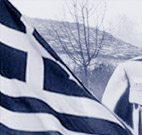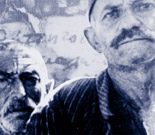 |
 |
 |
 |
 |
 |
 |
 |
||||||||||||
|
|
|||||||||||||||||||
Atonement Measures |
The author researched the lives of the two generals meticulously and shows how Felmy, who was basically a moderate, conciliatory man and Le Suire who was more uncompromising and ruthless, finally ordered the execution of hostages in order to cope with the growing force of resistance movements. The writer describes the role of the British who were parachuted into the peninsula to support and equip the freedom fighters with weapons. He follows the lives of the men who led the partisans and describes the immense suffering of the civilian population, who were always the ones to bear the brunt of the bloody clashes, no matter what the partisans, the British, Italians or Germans did. British policy was very clumsy, however. By supporting the royalist faction of the resistance (ES), they turned the leftwing movement of the ELAS/EAM, infiltrated by the communist party of Greece (KKE), against themselves and each other. Terrible battles ensued, leading finally to the elimination of the ES by ELAS. Those fleeing from ES, who could not count on help from the British any more, ran straight into the arms of the Germans. They were used directly against their leftwing compatriots and grouped into so-called security battalions (Tagmata Asfaleias) at the end of 1943 and the beginning of 1944. The scene was set for civil war. Meanwhile, the Italians capitulated in September 1943. The German troops were too thinly distributed over the peninsula to control their arms dumps so that large quantities of war material fell into the hands of the rebels who used them against the occupier. The Germans threatened to kill hostages but partisan attacks continued. In November 1943 the Germans shot the first hostages. Twenty-seven further atonement measures followed, called Sühnemaßnahmen. The security battalions often supported these. The author is able to reconstruct a complete picture of the horror by using eyewitness accounts, military documents and legal proceedings. In the time until the Germans retreated in the autumn of 1944, at least 2,319 hostages who were mostly innocent, paid with their lives for the death of at least 370 murdered Germans. The main theme of the book concerns itself with “Operation Kalavryta”: Seventy-eight German soldiers were captured in October 1943 in a skirmish with freedom fighters whose leaders came from the township of Kalavryta. Soon afterwards, three of the 78 Germans were murdered close to Kalavryta and the monastery of Aghia Larva (which was the birthplace of the freedom movement in 1821). Negotiations for an exchange of prisoners went on for weeks until Le Suire lost patience and ordered that the partisan strongholds should “be cleansed” with a view to freeing the captives. His express orders were that “the enemy is to be attacked forthwith and heavy weapons used to annihilate him” and that “every village using gunfire (…) should be burnt to the ground and all the men shot”. The tactic failed because, confronted with the German advance, ELAS murdered their prisoners of whom two survided the execution. In addition, the Germans were unable to come to grips with their enemy as the partisans had melted away from the area around Achaia. The author tells a terrible story of the events. He visited almost all the villages, consulted documents in more than two dozen libraries and archives and interviewed eyewitnesses in Germany, Greece, Austria, France and England. His research shows that at least 681 civilians were slaughtered. More than 50 villages and three monasteries were either totally or partly demolished. About 1.000 houses were burnt down and in most cases their contents pillaged. Over 2.000 sheep and larger animals were herded off to German encampments and about 260 million drachmas stolen in order - in military speak - “to deny the Greek civilians their life support systems”.
Out of the above total of 677, precisely 477 people were shot in Kalavryta on December 13th 1943. The Germans reported 696 executions, but the discrepancy can be explained: On the one hand, there were 15 survivors of Kalavryta and Rogoi and on the other hand fugitives were picked up and killed as the Germans carried out the operations. Le Suire was a stickler for exact reports from his officers, so that it may be assumed with confidence that the numbers given by his division are correct. Taking into account those who survived, the total number of civilians shot in the operation was at least 681. H.F. Meyer studied case files of the Nuremberg trials and two other investigations conducted by the public prosecutors offices in Munich and Bochum after the war and he finds evidence to suggest that the competent public prosecutors were singularly dilatory. Legal proceedings were never initiated against the perpetrators because the prosecution deemed them to be untraceable. The author proves, however, that two of the main perpetrators were living in Austria at the time of the investigation. They were never called to justice till they died. After “Operation Kalawrita” the battle against the resistance moved to the southern half of the Peloponnese. There were constant attacks with corresponding retaliation by the Germans. The brutal culmination was reached when the German General Krech and three companions were found dead. As a result Germans and collaborating Greek "Security Bataillons" (Tagmata Asfaleias) shot 335 hostages. When the Germans retreated from the Peloponnese in October, they left behind a demolished infrastructure and a ravaged land. The only laudable exception was the seaport of Patras where the Swedish delegate of the International Red Cross, Hans Ehrenstrale, negotiated hard to ensure that the harbour installations remained intact. Fate caught up with the 117th Jaeger-Division on its retreat through Yugoslavia. It lost more soldiers in two days in the battle for Belgrade than in the entire course of the war. The division withdrew to Austria in spring 1945 and fought against the invading Red Army and continued to fight a desperate rear guard battle for a day after the capitulation. The soldiers’ concern was to be taken prisoner by the American army rather than by the Russians. They achieved this. The Americans disarmed them and sent them home. The author’s research shows, however, that more than 6.000 members of the division lost their lives during the war. The book has 560 pages and contains about 240 facsimiles and photos, many of which are unique. It can be obtained in bookshops or direct from www.rutzen-verlag.de |
           |
|||||||||||||||||
|
|||||||||||||||||||
